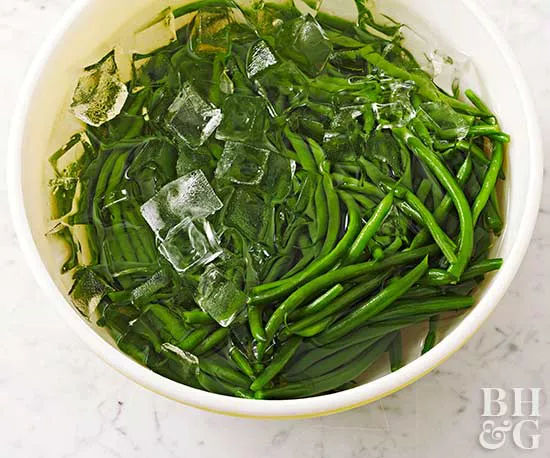How to Blanch Vegetables to Add to All Kinds of Recipes

You may have heard cooking shows (or your mom) mention the cooking term "blanching," but if someone asked you how to blanch vegetables, perhaps green beans, would you know how? Now you will. Blanching is a heat-and-cool process that plunges a fruit or vegetable into boiling water briefly before transferring it to an ice bath, quickly stopping the cooking. Also known as parboiling, this quick and simple (yet super useful) technique is most beneficial in getting vegetables ready for canning or freezing because it improves the texture and keeps their colors bright.
Why Do I Need to Know How to Blanch Vegetables?
Many veggies, such as carrots, peas, and asparagus, benefit from blanching before freezing to maintain their color and texture, but here are more reasons to know how to blanch vegetables and add this method to your food prep:
- Blanching loosens the skin of tomatoes and peaches so you can easily peel them.
- When freezing vegetables, blanching slows the natural enzymes in the vegetables that can cause loss of flavor, texture, and color.
- Blanching cleans the surfaces of fruits and vegetables to remove dirt and organisms and can also reduce bitterness.
- It brightens the color of certain vegetables, especially broccoli and other green veggies. Vibrant blanched veggies are appetizing on a party tray with dip (plus generally eaten much more quickly than raw veggies).
- Blanching helps to slow the loss of nutrients.
- Longer-cooking vegetables can be blanched before grilling, especially when used on kabobs with quicker-cooking produce and meat.
How to Blanch Vegetables
For blanching any vegetable, start by filling a large pot with water, using 1 gallon of water per pound of prepped vegetables.
- Heat water to boiling. Add washed and trimmed veggies to the boiling water (or place them in a wire basket and lower it into the water; cover.
- Cook the vegetables in boiling water for 1 to 5 minutes (see below for example times). When the color of the veggie you're cooking becomes bright and vibrant, it's done.
- Fill a large, clean bowl with ice water. When blanching time is complete, use a slotted spoon to remove the veggies from the boiling water.
- Immediately plunge veggies into the ice water. Chill for the same amount of time they were boiled; drain in a colander.
Test Kitchen Tip
You can also quick-blanch veggies by bringing a whole kettle of water to boiling and pouring the boiling water over them in a heat-safe bowl. If you use this technique, let the veggies stand in hot water for the time specified below instead of boiling on the stovetop.
Blanching Times for Vegetables
Not all vegetables require blanching, but these are the most common veggies that benefit from the technique.
- Asparagus: Blanch small asparagus spears 2 minutes, medium spears 3 minutes, and large spears 4 minutes.
- Broccoli: Blanch small broccoli florets 3 minutes. The broccoli should turn bright green and barely tender.
- Carrots: Blanch small whole carrots 5 minutes and cut-up carrots 2 minutes.
- Beans (green, Italian, snap, and wax): Working in batches, boil small beans for 2 minutes, medium beans for 3 minutes, and large beans for 4 minutes.
- Peas (English or green): Blanch 1½ minutes.
How to Blanch Tomatoes or Peaches
Blanching makes tomatoes easy to peel and protects their quality when freezing or prepping them for canning. Use peeled tomatoes for sauces and salsas, too. This same technique works well for peeling peaches. After your water is boiling, follow these steps:
- Cut a shallow X on the bottom of each tomato with a sharp paring knife. This encourages the skin to split during blanching, so you can slip it off once the tomato has cooled.
- In batches of four to six tomatoes, immerse tomatoes in boiling water 30 to 60 seconds until the tomato skins split open. Use a slotted spoon to move the tomatoes around, submerging all sides.
- When the skins are split, use the slotted spoon to carefully transfer the tomatoes to the bowl of ice water. Once the tomatoes are cool, remove them from the ice bath and drain them on paper towels.
- Now, it's time to peel the tomatoes. Using your fingers or the tip of a knife, you should be able to easily pull the skin away from the flesh in two to four pieces.
How to Blanch Corn
Place corn, a few cobs at a time, in boiling water for 4 minutes. After corn has cooled in an ice bath, remove and cut kernels from the cob. Use immediately or store in freezer-safe bags.
Your blanched vegetables will be nice and tender when finished. You can enjoy them in your favorite recipes or freeze them, so you have fresh veggies ready for meals. Remember to label and date them before they go in the freezer.
Tips for Prepping and Cooking Vegetables
Get the best tips for how to wash lettuce, or try your hand at sautéing mushrooms or onions for a delicious accompaniment to a grilled steak. Learn how to shred vegetables to add to salads, make cole slaw, or use in recipes. Knowing the right way to roast vegetables will get you crisp, delicious results every time you prepare them, from green beans to broccoli.